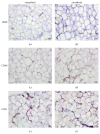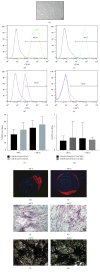Adipose Derived-Mesenchymal Stem Cells Viability and Differentiating Features for Orthopaedic Reparative Applications: Banking of Adipose Tissue
- PMID: 28018432
- PMCID: PMC5153503
- DOI: 10.1155/2016/4968724
Adipose Derived-Mesenchymal Stem Cells Viability and Differentiating Features for Orthopaedic Reparative Applications: Banking of Adipose Tissue
Abstract
Osteoarthritis is characterized by loss of articular cartilage also due to reduced chondrogenic activity of mesenchymal stem cells (MSCs) from patients. Adipose tissue is an attractive source of MSCs (ATD-MSCs), representing an effective tool for reparative medicine, particularly for treatment of osteoarthritis, due to their chondrogenic and osteogenic differentiation capability. The treatment of symptomatic knee arthritis with ATD-MSCs proved effective with a single infusion, but multiple infusions could be also more efficacious. Here we studied some crucial aspects of adipose tissue banking procedures, evaluating ATD-MSCs viability, and differentiation capability after cryopreservation, to guarantee the quality of the tissue for multiple infusions. We reported that the presence of local anesthetic during lipoaspiration negatively affects cell viability of cryopreserved adipose tissue and cell growth of ATD-MSCs in culture. We observed that DMSO guarantees a faster growth of ATD-MSCs in culture than trehalose. At last, ATD-MSCs derived from fresh and cryopreserved samples at -80°C and -196°C showed viability and differentiation ability comparable to fresh samples. These data indicate that cryopreservation of adipose tissue at -80°C and -196°C is equivalent and preserves the content of ATD-MSCs in Stromal Vascular Fraction (SVF), guaranteeing the differentiation ability of ATD-MSCs.
Conflict of interest statement
The authors declare that there is no conflict of interests regarding the publication of this paper.
Figures







Similar articles
-
Cryopreservation of whole adipose tissue for future use in regenerative medicine.J Surg Res. 2014 Mar;187(1):24-35. doi: 10.1016/j.jss.2013.09.027. Epub 2013 Oct 8. J Surg Res. 2014. PMID: 24268882
-
Study on viability and chondrogenic differentiation of cryopreserved adipose tissue-derived mesenchymal stromal cells for future use in regenerative medicine.Cryobiology. 2015 Oct;71(2):256-63. doi: 10.1016/j.cryobiol.2015.07.007. Epub 2015 Jul 21. Cryobiology. 2015. PMID: 26209137
-
Cryopreservation of heat-shocked canine adipose-derived mesenchymal stromal cells with 10% dimethyl sulfoxide and 40% serum results in better viability, proliferation, anti-oxidation, and in-vitro differentiation.Cryobiology. 2020 Feb 1;92:92-102. doi: 10.1016/j.cryobiol.2019.11.040. Epub 2019 Nov 28. Cryobiology. 2020. PMID: 31785238
-
Adipose Tissue-Derived Pericytes for Cartilage Tissue Engineering.Curr Stem Cell Res Ther. 2017;12(6):513-521. doi: 10.2174/1574888X12666170321111211. Curr Stem Cell Res Ther. 2017. PMID: 28325151 Review.
-
Repair of injured articular and growth plate cartilage using mesenchymal stem cells and chondrogenic gene therapy.Curr Stem Cell Res Ther. 2006 May;1(2):213-29. doi: 10.2174/157488806776956904. Curr Stem Cell Res Ther. 2006. PMID: 18220868 Review.
Cited by
-
Adipose Stem Cell Translational Applications: From Bench-to-Bedside.Int J Mol Sci. 2018 Nov 5;19(11):3475. doi: 10.3390/ijms19113475. Int J Mol Sci. 2018. PMID: 30400641 Free PMC article. Review.
-
Osteogenic Differentiation Modulates the Cytokine, Chemokine, and Growth Factor Profile of ASCs and SHED.Int J Mol Sci. 2018 May 14;19(5):1454. doi: 10.3390/ijms19051454. Int J Mol Sci. 2018. PMID: 29757956 Free PMC article.
-
Adaptive Regulation of Osteopontin Production by Dendritic Cells Through the Bidirectional Interaction With Mesenchymal Stromal Cells.Front Immunol. 2018 Jun 1;9:1207. doi: 10.3389/fimmu.2018.01207. eCollection 2018. Front Immunol. 2018. PMID: 29910810 Free PMC article.
-
How to maintain and transport equine adipose tissue for isolating mesenchymal stem cells?BMC Vet Res. 2022 Jul 21;18(1):284. doi: 10.1186/s12917-022-03379-1. BMC Vet Res. 2022. PMID: 35864533 Free PMC article.
-
Isolation of Adipose-Derived Stem/Stromal Cells from Cryopreserved Fat Tissue and Transplantation into Rats with Spinal Cord Injury.Int J Mol Sci. 2018 Jul 5;19(7):1963. doi: 10.3390/ijms19071963. Int J Mol Sci. 2018. PMID: 29976859 Free PMC article.
References
-
- Friedenstein A. J., Chailakhjan R. K., Lalykina K. S. The development of fibroblast colonies in monolayer cultures of guinea-pig bone marrow and spleen cells. Cell and Tissue Kinetics. 1970;3(4):393–403. - PubMed
LinkOut - more resources
Full Text Sources
Other Literature Sources
Research Materials

